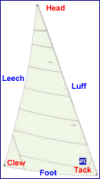There are many places to go when looking for used or new sails. Here are a few
links for new & used sail lofts:
Most of the sail lofts listed above have specs for the Chrysler sails.

Before you look at new or used sails, you need to know what size sail is right for your boat. The best way to figure out what size sail you need is to measure your boat. Please look at the drawing above. These are the basic rig dimensions for a sail boat. For sizing head sails be sure to measure the forestay length. If you have roller furling, it is important to have the length from the top swivel to the drum, or the pin to pin dimension on the furling system.
The I, J, P, and E, dimensions refer to the dimensions of the boat. Sails are described with another set of terms. The luff is always the leading edge of the sail. The leech is always the trailing edge of the sail, and the foot is always the bottom of the sail. The LP of a Genoa is used to figure what size sail it is. Multiply the J dimension times the size sail you want and this will give you the LP of the sail.
For example, lets say your boat has a J dimension of 12'feet, and you are looking for a 150% Genoa. Simply multiply your J of 12'times 1.5 to get an LP of 18' for your 150% Genoa. Head sails that are not Yankee cut (high cut) have an LP 1'-1.5' shorter than the foot of the sail.
Don't worry. Measuring your boat for a new set of sails is easy to do yourself. All you need is a long tape measure.

The first thing you need to do is hoist a tape measure up your main halyard. You may want to tie a line to the halyard in case your tape breaks, you won't have to go up the mast to get the halyard. Hoist the tape all the way up until it stops and measure down to where the tack of the sail attaches at the front of the boom. This will be the maximum luff of the main sail. While the tape is at the top of the mast, pull it to the back of the boom where the clew of the sail will be. Hold the boom at the height you want it to be when the sail is up. This measurement will be your leech dimension. After you get these two dimensions, lower the tape. Then take a measurement from where the tack of the sail attaches at the front of the boom, back to the maximum useable space at the end of the boom. This will be your maximum foot dimension.

Hank on head sails are easy to measure for. Simply hoist a tape measure up your jib halyard. Remember to tie a line to the halyard so you don't lose your halyard if the tape breaks. Hoist the tape all the way to the top of the mast and measure down the forestay to the deck. This will be your maximum luff length. While the tape is up, measure straight down the mast to the working deck, not the cabin top. This is your "I" dimension. After you have these dimensions, lower the tape. Then measure from where the forestay connects at the bow, back in a straight line to the base of the mast. This is the "J" dimension.
If you have a roller furling head sail you will measure everything the same except for the luff. To measure the luff, attach the tape to the top spindle of the roller furling system, just like you would the head of the sail. Hoist the spindle all the way to the top and measure down to where the bottom of the sail attaches to the top of the furling drum. If you have a roller furling head sail we will also need to know the diameter of the luff tape. The luff tape is the small cord on the luff of the sail that attaches the sail to the furling system. The last thing we will need to know for a roller furling sail is which side of the sail you would like the cover cloth to be on, port or starboard.
If you take all the dimensions above, a head sail can be made that will work great for 99% of the boats on the water today. If you have a short Genoa track, or a track that is very far aft, or very far forward you might want to take a few more dimensions. If you have a fairlead that is fixed and not on a track, you will have to take these dimensions. While you have the tape measure at the top of the mast measure down to the forward end of your Genoa track, and measure down to the aft end of the Genoa track. If you have a fairlead that is fixed, measure down to it. After you get these two dimensions, lower the tape. Then measure from where the forestay attaches to the bow, back in a straight line to the front of the Genoa track, and to the back of the Genoa track. If you have a fixed fairlead simply measure to it. If you supply these dimensions, the sail loft can make sure your new sail will sheet in correctly.
Note: Contents of this page borrowed from Atlantic Sail Traders.